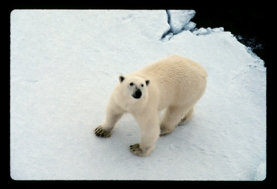Polar bears could face mass starvation and reproductive failure across the entire Canadian archipelago by the end of the century, suggesting an area once considered a last refuge for the animals may no longer be a very good one, according to a new study.
While polar bears have long been the poster child for climate change, less is understood about the future population in the archipelago, as its narrow channels and complex geography make forecasting and analysis of sea ice difficult. Some earlier work had suggested that polar bears might fare reasonably well in swaths of northern Canada by the end of the century, as sea ice is more resilient there than in some other habitats.
“This area is not going to be the salvation for polar bears … this is no longer the place of security that we had perhaps hoped it was going to be,” said Andrew Derocher, biological sciences professor at University of Alberta and co-author of the study, published in PLOS ONE.
The archipelago sits north of the Canadian mainland and consists of more than 30,000 islands, cut by waterways making up the Northwest Passage.
The research team from Canadian universities found that seven populations of archipelago bears—which currently number in the thousands and constitute roughly a quarter of the global total of the animals—could be in jeopardy after midcentury, as more areas become ice-free for part of the year and longer periods of time. They analyzed projections of future sea ice concentration, snow depth and ice thickness between 2006 and 2100 and compared those estimates to what is known about the energy needs of bears.
No ice, no prey
When habitat is free of sea ice for 180 days, for instance, it’s estimated that 9 to 21 percent of adult male polar bears face starvation, with other ages and classes being more vulnerable. Early break up of sea ice in the summer, meanwhile, can cause up to 100 percent reproductive failure in pregnant females, as they must move to land and fast during a critical gestation time.
“Polar bears feed primarily on two species of seals—ringed seals and bearded seals—both of which they have access to from the ice, but not from the land,” said Stephen Hamilton, a scientist at University of Alberta and co-author of the paper.
The study reports that four of the populations in the south and central archipelago could witness ice-free conditions five months of the year by century end. Others may see two to four months of ice-free conditions, while they are seeing no ice-free periods now.
Ice also will break up several months earlier, creating a reproductive challenge for females. By 2070, more than 80 percent of the archipelago might experience ice-break up in July, the study says. Snow depth also may halve in most of the studied habitats, creating a food supply problem as ringed seals require 20 centimeters of snow typically, Hamilton said.
Current data on the bears is spotty, although statistics indicate that some of the archipelago populations are stable right now.
Little chance seen for adaptation
“Nevertheless, by 2100 all regions of the study area may cross the critical point of no-return,” the paper says. Hamilton said there is little reason to believe that polar bears would adapt to be a terrestrial species, considering historical evidence in the Baltic Sea. Polar bears lived there during the last ice age, for example, but were wiped out after a warming period.
Populations elsewhere already are declining—earlier this month, scientists reported that the polar bear population off Alaska and western Canada declined by at least 25 percent during the first decade of this century (ClimateWire, Nov. 19).
However, the researchers in the new paper use an aggressive emissions scenario, assuming that temperatures will rise by approximately 3 degrees Celsius or more by century’s end.
While that is possible according to scientific projections, it is a “worst-case scenario” for emissions, said David Douglas, a research wildlife biologist and polar bear expert at the U.S. Geological Survey. “They are putting all their eggs in the basket of one model,” he said.
At the same time, he praised the paper for its downscaling of climate models—which typically have poor resolution of the area—to get a more complete snapshot of what may happen. While scientists have performed similar downscaling, “no one had done it with sea ice to address polar bear habitat.”
“It’s not just a rehash of the same old stuff,” he said.
The study received funding from the Canadian government, along with several other groups, including the Canadian Association of Zoos and Aquariums and the Natural Sciences and Engineering Research Council of Canada.

